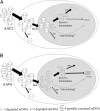Existence of transient functional double-stranded DNA intermediates during recombinant AAV transduction
- PMID: 17664425
- PMCID: PMC1941794
- DOI: 10.1073/pnas.0702778104
Existence of transient functional double-stranded DNA intermediates during recombinant AAV transduction
Abstract
Previous studies have documented that 0.1 approximately 1% of input recombinant adeno-associated virus (rAAV) vectors could be stabilized and lead to transgene expression. To characterize the steps involving massive AAV DNA loss, we designed an"AAV footprinting" strategy that can track newly formed AAV dsDNA genomes. This strategy is based on an ROSA26R mouse model or cell line that carries a lacZ gene flanked by two loxP sites. When it is transduced by a rAAV vector carrying the Cre recombinase, the lacZ gene can be activated and remain active even when rAAV genomes are later lost. By using this sensitive AAV footprinting technique, we confirmed the existence of transient AAV dsDNA that went undetected by conventional DNA methods. Although these dsDNA intermediates could be efficiently formed in almost every cell and were competent for mRNA transcription and protein synthesis in vivo, they got lost continuously. Only a small fraction was eventually stabilized for sustained gene expression. Although both rAAV2 and rAAV8 can potentially have similar levels of dsDNA formation, AAV8 dsDNA was formed much faster than that of AAV2, which explains why rAAV8 is more efficient than rAAV2 in transducing the liver. Collectively, our studies suggested that rather than receptor binding, viral entry, and ssDNA to dsDNA conversion, the instability of newly formed AAV dsDNA was the primary contributing factor for the low rAAV transduction efficacy. The uncoating step significantly influenced the stability of AAV transient dsDNA. The identification of transient AAV dsDNA provided a new pathway for improving rAAV transduction.
Conflict of interest statement
The authors declare no conflict of interest.
Figures






References
-
- Muzyczka N, Berns KI. In: Fields Virology. Knipe DM, Howley PM, Griffin DE, Lamb RA, Martin MA, Roizman B, Straus SE, editors. Philadelphia: Lippincott Williams & Wilkins; 2002. pp. 2327–2359.
-
- Flotte TR, Berns KI. Hum Gene Ther. 2005;16:401–407. - PubMed
-
- Wang Z, Zhu T, Qiao C, Zhou L, Wang B, Zhang J, Chen C, Li J, Xiao X. Nat Biotechnol. 2005;23:321–328. - PubMed
-
- Herzog RW, Yang EY, Couto LB, Hagstrom JN, Elwell D, Fields PA, Burton M, Bellinger DA, Read MS, Brinkhous KM, et al. Nat Med. 1999;5:56–63. - PubMed
-
- Fisher KJ, Jooss K, Alston J, Yang Y, Haecker SE, High K, Pathak R, Raper SE, Wilson JM. Nat Med. 1997;3:306–312. - PubMed
Publication types
MeSH terms
Substances
Grants and funding
LinkOut - more resources
Full Text Sources
Other Literature Sources

